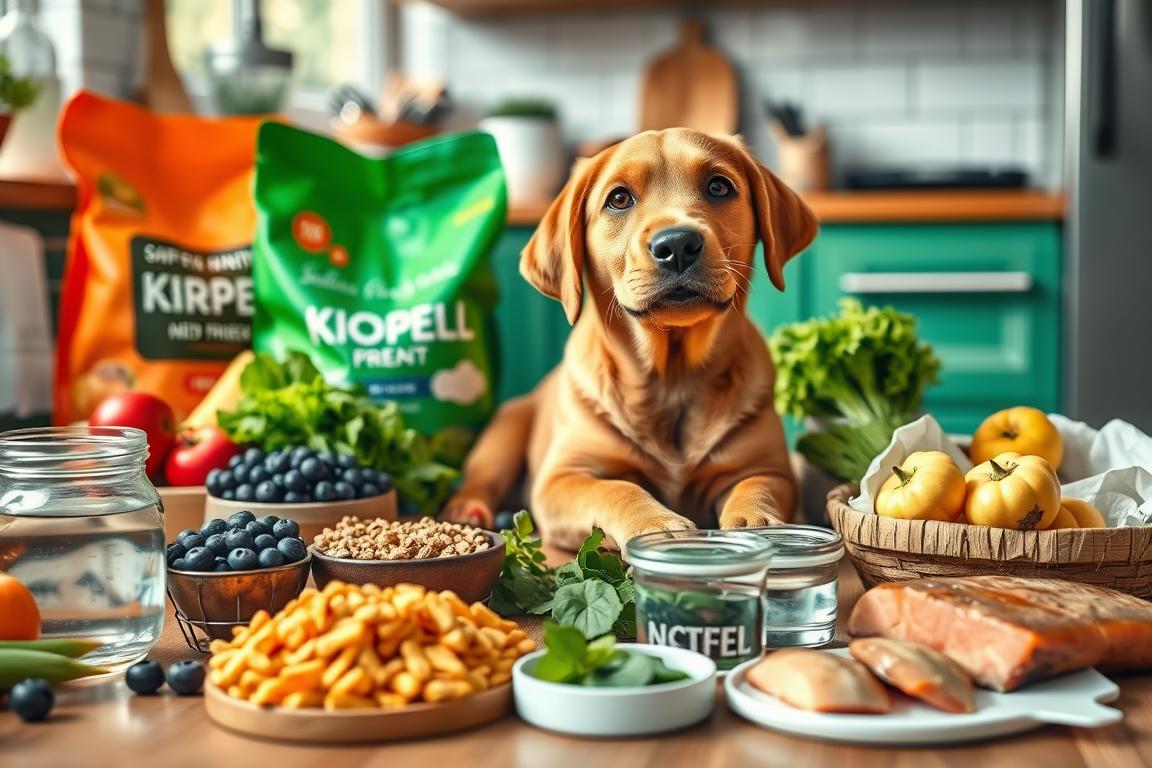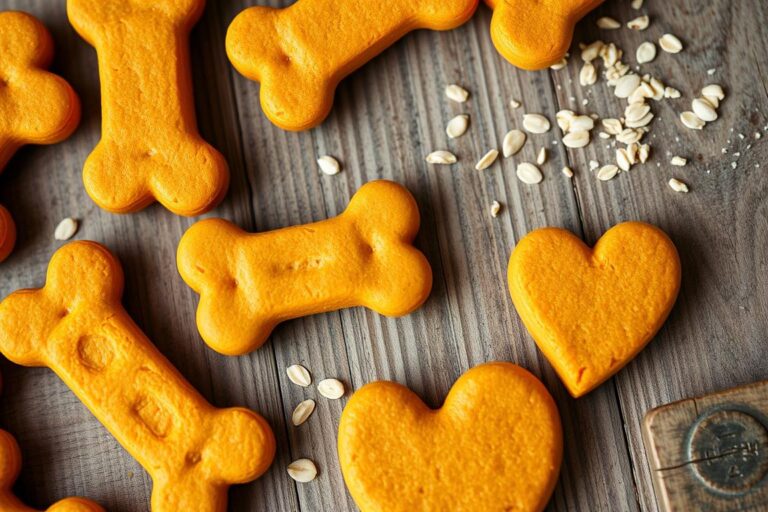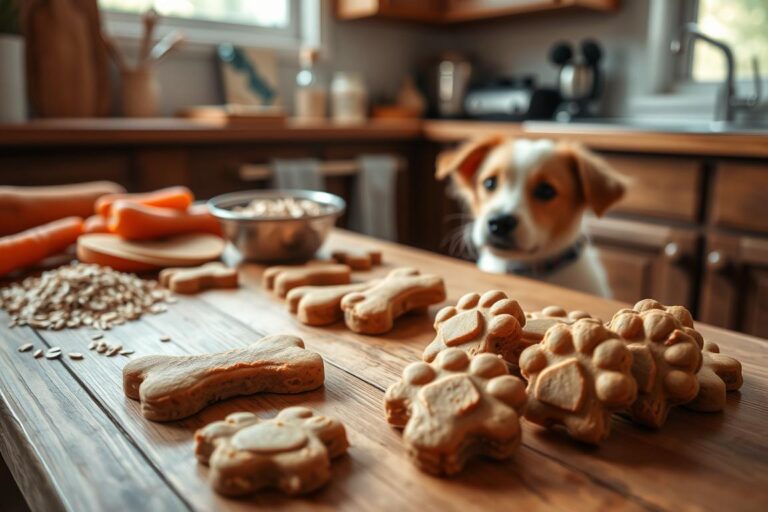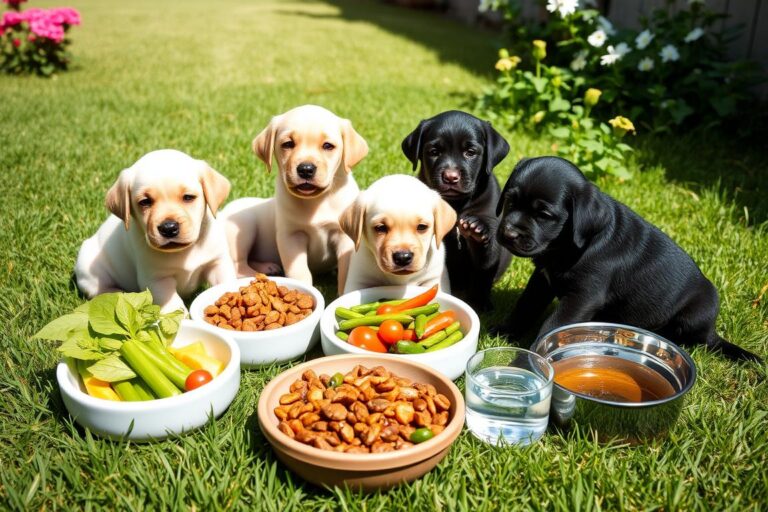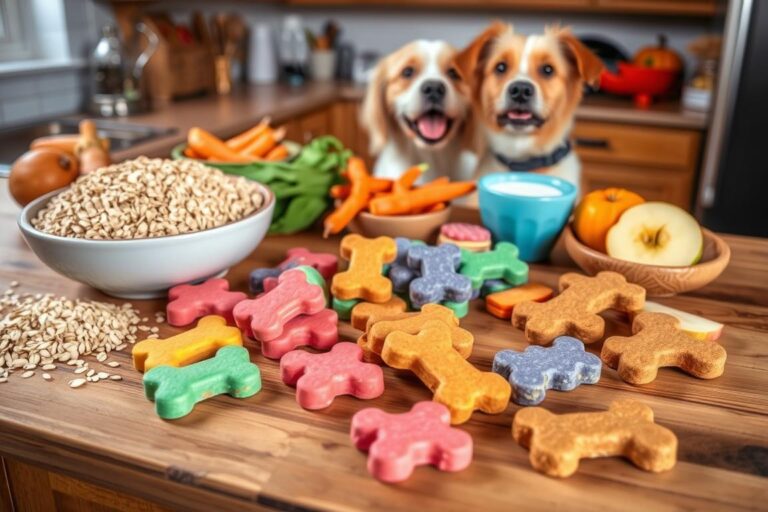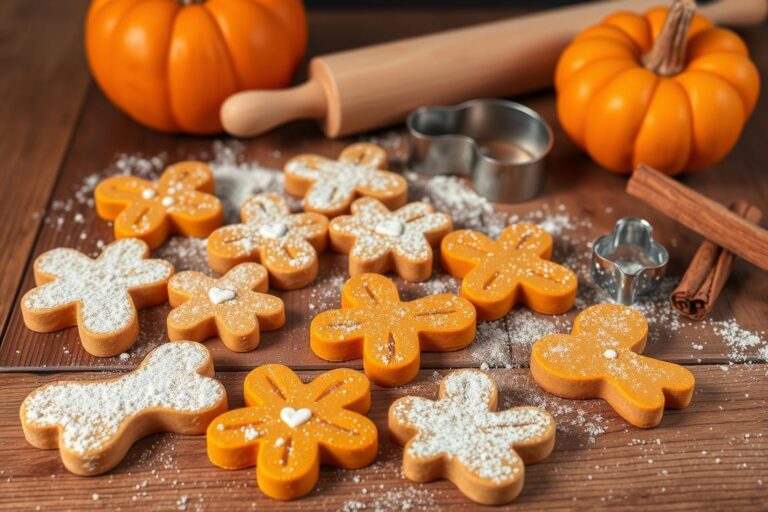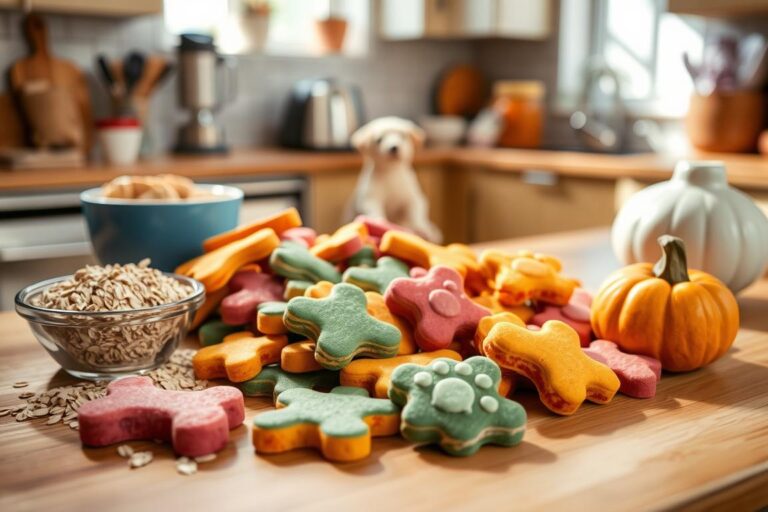Optimal Nutrition: Best Diet for Labrador Puppy
The Labrador Retriever is a favorite breed. They are known for being friendly and full of energy. To help our Labrador puppies grow strong and healthy, we need to give them the right food.
Good nutrition is key to prevent obesity and bone problems. Knowing what to feed them is important. It’s not just about the food, but also how much and when to feed.
There are many ways to feed our puppies, like kibble, raw food, wet food, and homemade diets. Choosing the right food helps them grow and stay healthy. We will look at each option to make sure our puppies get the best.
Understanding Your Labrador Puppy’s Nutritional Requirements
Labrador puppies grow fast. They need a good labrador puppy diet plan to stay healthy. This plan should have proteins, fats, carbs, vitamins, and minerals.
Labradors eat both meat and plants. Proteins help their muscles grow. Fats give them energy and keep their skin and fur shiny. Carbs help their digestion, and vitamins and minerals keep them well.
Vitamins A and E are good for their skin and eyes. Vitamin D, calcium, and phosphorus make their teeth and bones strong. Potassium helps their heart. Glucosamine and chondroitin are good for their joints.
As puppies get older, their nutritional requirements for labrador puppy change. We need to adjust their labrador puppy diet plan to match. A mix of good kibble, raw food, or homemade meals helps them grow right.
Best Diet for Labrador Puppy: Key Components
Labrador puppies need a balanced diet for growth and health. A good diet helps them grow right and stay healthy. It’s important to mix proteins, fats, and carbs well.
Balancing Proteins, Fats, and Carbohydrates
A good diet for puppies has 25-30% protein, 8-15% fat, and 30-50% carbs. Proteins from chicken, beef, and fish are key for muscles. Fats, like omega fatty acids, keep energy up and skin healthy.
Essential Vitamins and Minerals
Labrador puppies need vitamins and minerals for bones and health. Vitamins A, D, and E, and minerals like calcium, are important. They help with growth, especially as puppies grow into adults.
A balanced diet prevents problems like hip dysplasia. This ensures our puppies stay healthy.
Types of Food Suitable for Labrador Puppies
Choosing the right food for our Labrador puppies is very important. It affects their growth and health. We need to pick foods that are good for them and meet their needs.
Puppy Kibble: An Overview
Puppy kibble is a popular choice for new puppy owners. It has the right mix of food for growing Labradors. It has about 28% – 30% protein from animal sources like chicken or lamb.
The fat content is at least 18%. This gives them the energy they need.
Raw Diet: Benefits and Risks
Some dog owners like the raw diet for their puppies. They say it makes their puppies more energetic, have healthier coats, and better teeth. But, there’s a risk of getting sick from bad food.
Wet Food Options for Your Lab Puppy
Wet food is tasty and hydrating for Lab puppies. It’s a nice change from kibble. But, it might cost more and we need to make sure it’s nutritious.
Homemade Diets: What You Need to Know
Homemade diets can be good if done right. They let us tailor the food to our puppy’s needs. We need to make sure it has all the vitamins and minerals.
Safe ingredients like brown rice, carrots, and plain yogurt are good. Knowing about dog nutrition helps us avoid problems.
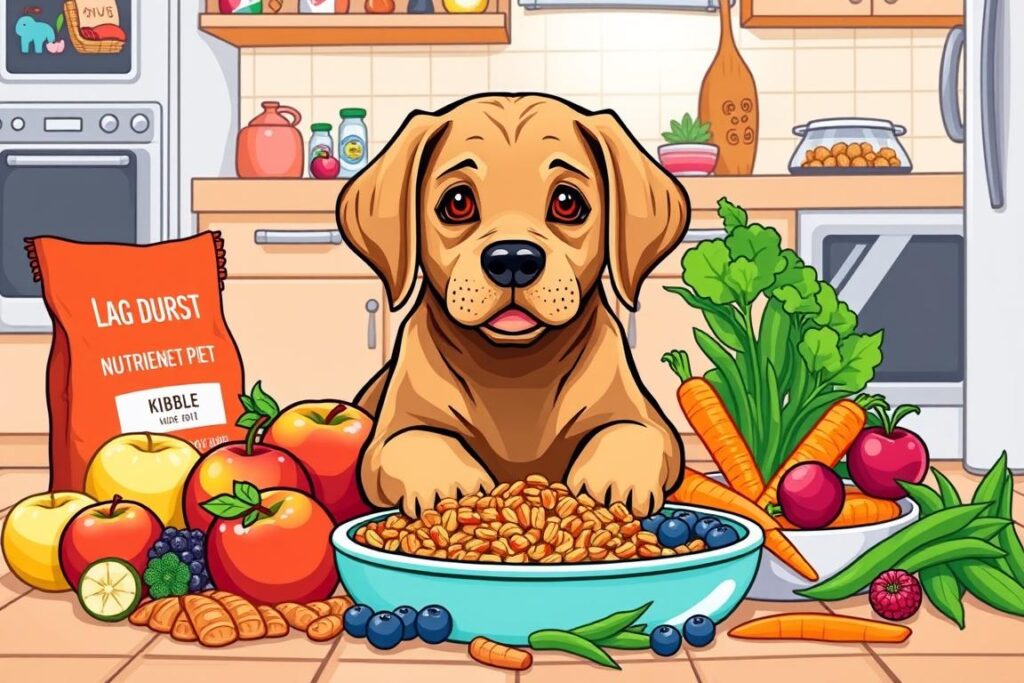
| Food Type | Protein Content | Fat Content | Benefits | Risks |
|---|---|---|---|---|
| Puppy Kibble | 28% – 30% | ≥ 18% | Balanced nutrition, cost-effective, convenient | Quality varies, may contain fillers |
| Raw Diet | High (varies) | Varies | Improved energy, healthy coat | Risk of bacterial infections |
| Wet Food | Varies (check labels) | Varies (check labels) | Highly palatable, hydrating | Costly, may lack balanced nutrition |
| Homemade Diet | Varies | Varies | Customizable, fresh ingredients | Requires knowledge of canine nutrition |
Portion Control for a Healthy Growth
Feeding the right amount is key for our Labrador puppies to grow well. A good feeding guide helps them grow strong without getting too fat. We need to think about their age, weight, and the food they eat.
How Much to Feed Your Labrador Puppy
At first, our puppies need about 8 oz. of food, given three times a day. This helps them get the nutrients they need. Starting them on dry food early helps them stay healthy later.
As they get bigger, we must watch their weight and adjust their food. By 14 to 18 months, they stop growing and become adult dogs. Making sure they eat the right amount helps them stay at a healthy weight, which is important for Labradors.
Feeding Frequency Guidelines
We should feed our puppies three times a day until they are six months old. Then, we can switch to two meals a day. This helps them digest food better and avoid getting too fat.
Treats and snacks should not make up more than 10% of their diet. This helps their bones grow strong. Too much food can harm their bones, which is a big worry for big dogs like Labradors.
Labrador Puppy Feeding Guide by Age
Feeding our Labrador puppy changes as they grow. At 8 weeks, they need three meals a day. Each meal should be 1 to 1.5 cups of puppy kibble. This makes 3 to 4.5 cups a day.
If the puppy weighs 15-17 lbs, they might need 1 cup per meal. It’s important to watch their weight and adjust food as needed. This keeps them healthy and happy.
When they get to 3 to 6 months, we can start giving them three meals a day. They usually eat 2 to 3 cups of puppy kibble each day. By 6 months, we switch to two meals a day. This helps their stomach get used to adult food.
Keeping a regular feeding schedule is key. Puppies 8 to 12 weeks old eat 2 to 3 cups of kibble daily. At 11 weeks, we give them 3 cups to help them grow. By 12 weeks, we go back to 2 cups and three meals a day. This helps them grow right and avoid eating too much.
How often we feed them is also important. A regular meal schedule helps them eat right and grow well. Not giving them snacks between meals helps them stay at a healthy weight as they get bigger.
| Age | Meals per Day | Food Amount per Meal | Total Daily Amount |
|---|---|---|---|
| 8 weeks | 3 | 1 – 1.5 cups | 3 – 4.5 cups |
| 3 – 6 months | 3 | 2 – 3 cups | 6 – 9 cups |
| 6 months | 2 | 2 – 3 cups | 4 – 6 cups |
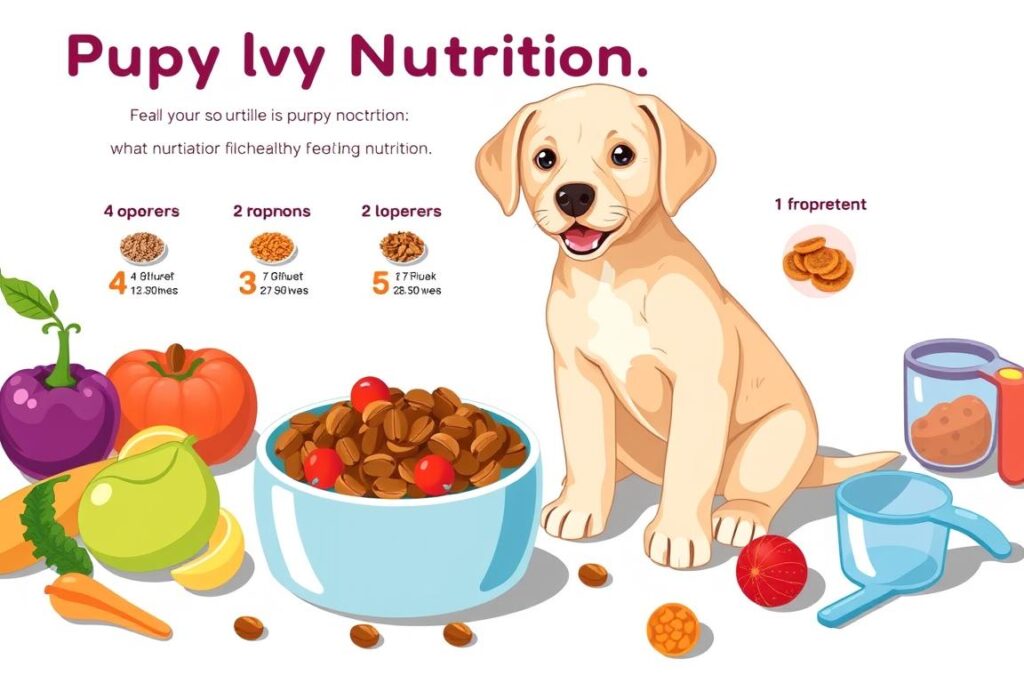
Choosing the Right Puppy Food Brand
Choosing a good puppy food brand is key for our Labrador puppies. We need to look for certain things in high-quality food. Good food has lots of protein from real meat, helping our pets grow strong.
Key Features of High-Quality Puppy Food
When we look for the best diet for our Labrador puppies, we need to know what makes good food. Here are some important things to remember:
| Feature | Description |
|---|---|
| High Protein Content | Should be 25 to 30% protein for strong muscles. |
| Real Meat Sources | Look for brands that list real meat first. |
| Balanced Nutrients | Includes vitamins and minerals like Omega-3 and Omega-6. |
| No Fillers | Avoid corn, soy, and other low-value ingredients. |
| No Artificial Additives | Watch out for artificial colors, flavors, and preservatives. |
Identifying Fillers and Additives
When we read puppy food labels, we must watch out for fillers and additives. Ingredients like corn, wheat, or soy are cheap but not very nutritious. They can make our puppies fat, leading to health issues like diabetes and arthritis.
By choosing the right food, we help our puppies stay healthy and happy.

The Role of Time in Feeding Your Labrador Puppy
It’s key to have a feeding schedule for our Labrador puppies. This helps keep them healthy and happy. A set routine helps with eating and digestion.
It’s important to follow a feeding guide for labrador puppy. This helps avoid health problems. It makes sure they get a balanced diet.
Optimal Feeding Schedule
Puppies from 6–12 weeks need four meals a day. This helps them grow fast and stay healthy. When they get to 3–6 months, we can cut it to three meals.
By 6–12 months, they can have two meals. This helps them get used to a routine. It’s good for their health.
Having a regular meal time helps with house training. It makes sure they go to the bathroom at the right time. We should space meals out to avoid tummy troubles.
It’s best to have meals every 12 hours. This makes a nice routine for them. It gives them a sense of security and predictability.
Watching how much they eat is important. If they stop eating, it might mean they’re sick. We should watch their weight and adjust food amounts as needed.
Don’t let them eat all day. It can make them fat. Stick to a schedule to keep them healthy.
| Age Range | Feeding Frequency | Key Notes |
|---|---|---|
| 6–12 weeks | 4 meals/day | Supports rapid growth. |
| 3–6 months | 3 meals/day | Transition phase for dietary habits. |
| 6–12 months | 2 meals/day | Establishes routine for adulthood. |
In conclusion, a structured feeding schedule is good for our Labrador puppies. It helps them stay healthy and behave well.
Top Diet Tips for Labrador Puppies
To keep our Labrador puppies healthy and strong, we need to follow some key diet tips. It’s important to avoid overfeeding them. Labradors can easily get too heavy, which can cause joint problems.
We should give them the right amount of food. For puppies aged 1.5 to 3 months, they need about 200g-300g of food each day. This food should be divided into several meals.
Avoiding Overfeeding Risks
As our puppies grow, they need more food. By 3-6+ months, they need around 300g-450g of dry food daily. Feeding them twice a day keeps them interested in eating.
Following a diet plan helps prevent overfeeding problems. A regular feeding schedule helps our puppies develop good eating habits. This leads to strong growth and lots of energy.
Monitoring Your Puppy’s Growth
Watching our puppy’s growth is very important. It helps us catch any weight problems early. A balanced diet from 15 months on is key for muscle growth and long life.
We can adjust the food portions and types to meet their needs. Whether they like Royal Canin or Taste of the Wild, the goal is balanced nutrition for their growth stages.

